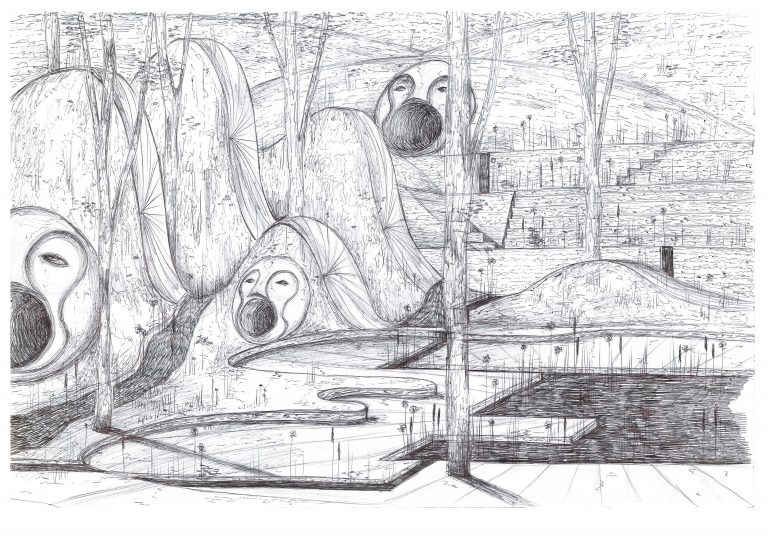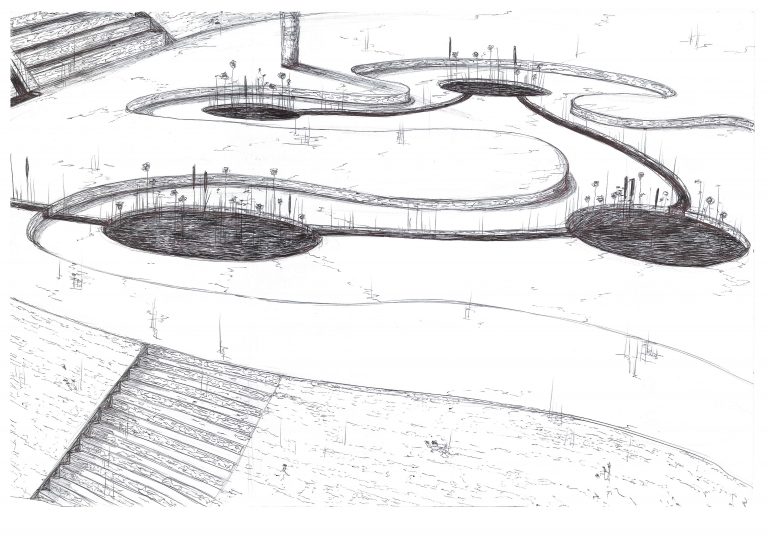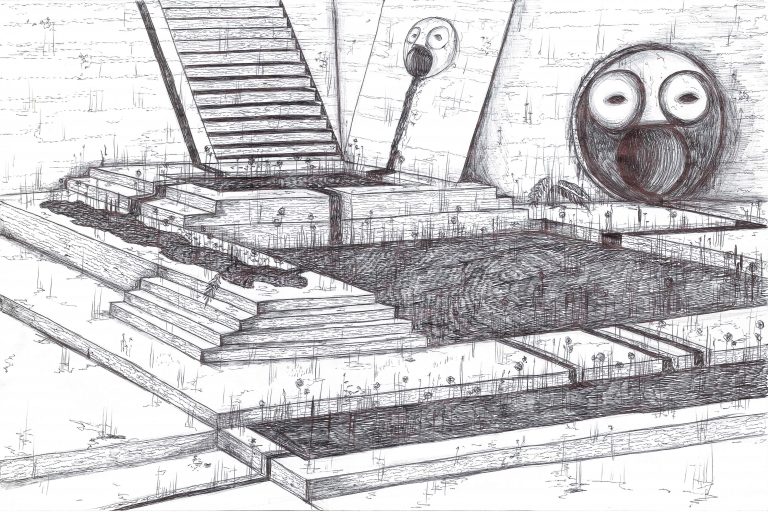System Crasher City
by Timo Feldhaus
For decades, Berlin has been the broken, dirty, crazy city that annoys others, that others don’t understand, that the rich, reasonable South Germans don’t want to pay for. That’s always been our thing. The local gallery scene has been using that same myth to catapult itself to the top of the art world since the late 90s. And now everyone has bad things to say about us: the collectors are fleeing, the museums can’t get their act together, and now the Berliners even want to get rid of Prussia (i.e. the State Museums of Berlin run by the Prussian Cultural Heritage Foundation). They say everything’s gotten boring by now. All downhill from here. What’ll become of us? Well, a lot, of course!
Berlin has the advantage of being a comparatively backward city. In contrast to other European capitals, it’s still a swamp here, where unclear, not yet finished, strange things blossom in the sludge like disgusting mushrooms that taste surprisingly exquisite in the end. That’s one reason why no one here really got what was meant with all the talk about the “systemic relevance” of art, proclaimed at the outset of the Corona crisis along with the excellent payouts to freelance artists. Of course art is existentially necessary! But what’s the relevance? Berlin sees itself as the spatialization of art’s original idea: subversion, or at least questioning the system, though actually permanently negating it. Berlin—always the system crasher par excellence!

Veit Laurent Kurz
Untitled (RElife Series), 2017

Veit Laurent Kurz
Untitled (RElife Series), 2017

Veit Laurent Kurz
Untitled (RElife Series), 2017
The effects of the pandemic will change a lot from now on. Things are headed in the direction of the sci-fi film Snowpiercer. There, a train with mankind’s last survivors permanently races around a completely frozen world. In this Noah’s Ark, the rich live in the front while the many poor are cramped in the back. Those in the back die and work hard, while those in the front celebrate in glorious decadence. There’s no exchange. Much like in the front part of the train, it will be harder to get into Berlin’s art world from now on. The walls are getting stronger; everything inside, more concentrated, harder. But also more happening-like, more rambling. There will be mergers like in New York, and the first rumours are already circulating about large gallery complexes on the Munich-Berlin axis. IRL gallery space will develop into an elitist capsule; many will leave it behind altogether. That’s where the opportunities are for smaller players: exciting digital exhibition spaces and virtual-reality presentations can be developed, even without a lot of money. We haven’t seen much of them so far. Though, online-only trading and live Internet auctions in higher price ranges are on the rise. It might not be much fun yet, but it’ll work. The most convincing argument: just because it’s new. And big. At Sotheby’s, a Francis Bacon triptych was recently auctioned off for 85 million USD online, making it the third highest auction price for a Bacon work ever.
But basically, if you want to look into the future, you have to look to Berlin Grünheide, where Elon Musk is building his insane Tesla Gigafactory. Everyone hopes he’ll build something onto it that involves art. In the future, art will have less to do with capitalism in the sense of pure profit; it’ll be more about symbolism again. Super wealthy philanthropists will pay of their own free will, because they want to appear in art. Because that’s what they’re supposed to be surrounded by, as part of their narrative. In this near future, artists will be just as poor, probably even a bit poorer than they’ve usually been since their invention. If you don’t want that, then everyone with a little money left will have to invest in the small players, even smaller ones, and then the tiny ones. Believe me, it’ll be worth it.
All drawings (Ballpoint pen on paper, 34 x 42 cm) are by Veit Laurent Kurz.
For more check out his book “Relife“, published by Hacienda Books.
Courtesy of Weiss Falk, Basel and the artist
Photos: Jason Klimatsas
Stadt der Systemsprenger
von Timo Feldhaus
Berlin ist seit Dekaden die kaputte, dreckige, durchgeknallte Stadt, die die anderen nervt, die die anderen nicht verstehen und für die der reiche, vernünftige Süden nicht zahlen will. Das war immer unser Ding. Auf diesem Mythos hat sich die hiesige Galerienszene (es waren die Galerien, nicht die Museen) seit Ende der 90er an die Kunst-Weltspitze katapultiert. Und jetzt reden alle schlecht über uns: Die Sammler verschwinden, die Museen zerstören sich selbst, jetzt soll auch noch Preußen zerschlagen werden (die Staatlichen Museen zu Berlin). Langweilig wär’s hier mittlerweile. Es geht alles den Bach runter. Was soll nur werden? Na, viel natürlich!
Denn Berlin hat den Vorteil, dass es immer noch eine vergleichsweise degenerierte Stadt ist. Im Gegensatz zu anderen europäischen Hauptstädten ist hier noch Sumpf, in dem sich Unklares, noch nicht Fertiges, Seltsames aus einem Schleim herausentwickelt wie ekelige Pilze, die am Ende ganz überraschend exquisit schmecken. Niemand hat hier daher so richtig verstanden, was es mit der Rede von der Systemrelevanz der Kunst bedeuten sollte, die mit dem Beginn der Corona-Krise und der hervorragenden Ausschüttung an die freischaffenden Künstler ausgerufen wurde. Natürlich ist Kunst existentiell notwendig! Aber das mit der Relevanz? Berlin versteht sich ja als die raumgewordene Originalidee von Kunst: subversiv, das System mindestens hinterfragend, eigentlich permanent verneinend. Berlin – immer schon der Systemsprenger schlechthin!
Durch die Auswirkungen der Pandemie wird sich nun vieles verändern. Es geht in Richtung des Science-Fiction-Films Snowpiercer. Dort rast ein Zug in einer völlig vereisten Welt immer um diese herum. In dieser Arche Noah sind ganz vorne die reichen und hinten ganz viele Arme angesiedelt. Die hinten sterben und arbeiten hart, die vorne feiern große Festspiele allerprächtigster Dekadenz. Es gibt keinen Austausch. Wie im Zug wird es in der Berliner Kunstwelt von nun an schwerer, reinzukommen. Die Mauern werden fester, im Inneren alles konzentrierter. Auch Happening-mäßiger, ausschweifender, härter. Es wird Zusammenschlüsse geben wie in New York, erste Gerüchte machen die Runde von großen Galerienkomplexen München-Berlin. Der echte Galerieraum entwickelt sich dabei zur elitären Kapsel, viele lassen ihn ganz hinter sich. Dort liegt die Chance für Kleinere: Aufregende digitale Ausstellungsräume und Virtual-Reality-Präsentation kann man auch ohne großes Geld machen. Bisher sieht man sie noch nirgends. Online-Only-Handel und Live-Internetauktion in höheren Preisbereichen nehmen zu. Das mag bisher noch nicht so viel Spaß machen. Aber es wird funktionieren. Das schlagendste Argument dafür: Einfach, weil es neu ist. Und groß. Bei Sotheby’s wurde zuletzt ein Francis Bacon Triptychon für 85 Millionen Dollar im Internet versteigert, es erzielte damit den dritthöchsten Auktions-Preis für ein Bacon-Werk überhaupt.
Aber im Grunde muss man, will man in die Zukunft sehen, nach Berlin Grünheide schauen, wo Elon Musk seine wahnsinnige Tesla Gigafactory baut. Alle hoffen, dass der einfach irgendwas mit Kunst dazu baut. Kunst wird in Zukunft weniger mit Kapitalismus im Sinne von reinem Profit zu tun haben, es wird wieder mehr um Symbolik gehen. Schwerreiche Philanthropen werden aus freien Stücken zahlen, weil sie in Kunst vorkommen wollen. Weil das um sie herum sein soll, als Teil ihrer Erzählung. In dieser nahen Zukunft wird der Künstler genau so arm sein, und wahrscheinlich sogar noch ein bisschen ärmer, als er es seit seiner Erfindung schon immer ist. Wenn man das nicht will, dann muss jeder, der gerade noch ein bisschen Geld über hat, in die Kleinen, noch Kleineren, und dann die Winzigkleinen investieren. Glauben Sie mir, es wird sich lohnen.
